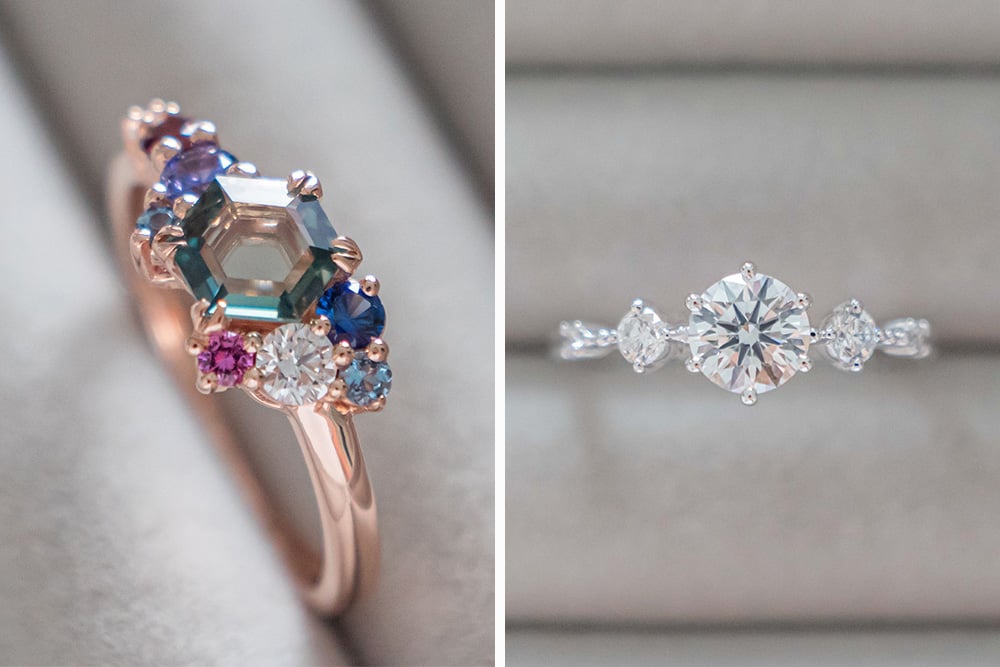When shopping for lab grown diamond rings, one of the most important features to consider is the setting, specifically the claws that hold the diamond in place. These small but mighty components not only impact the overall look of the ring but also play a crucial role in ensuring the durability and security of the diamond. Understanding the different types of claws for lab grown diamond rings can help you make an informed decision, whether you’re buying your first engagement ring or adding to a growing collection. This article will walk you through the various aspects of claws for lab grown diamond rings, from their function to design choices.
What Are Claws for Lab Grown Diamond Rings?
Claws for lab grown diamond rings are the prongs or small metal projections that grip the diamond securely within its setting. Typically found on the top of the diamond, the claws ensure that the stone stays in place while allowing light to pass through it, creating that beautiful sparkle. While the claws for lab grown diamond rings serve a similar purpose as those for natural diamonds, they are specially designed to accommodate the unique characteristics of lab-grown stones.
Since lab grown diamonds have the same physical properties as their natural counterparts, the claws used to secure them need to be just as durable and functional. The claws for lab grown diamond rings are designed to hold the stone firmly without interfering with its brilliance. It’s important to choose claws that are both practical and aesthetically pleasing to ensure that the diamond is well-supported while showcasing its beauty.
Types of Claws for Lab Grown Diamond Rings
There are several types of claws for lab grown diamond rings, each offering a different level of security and visual appeal. The most common types are the four-claw setting, six-claw setting, and bezel setting. Each has its own advantages depending on the style you desire and the level of security you require.
- Four-Claw Setting: This is the most popular setting for lab grown diamond rings. Four claws are positioned at the corners of the diamond, leaving the sides open to maximize light exposure. This creates a striking visual effect and allows the diamond to sparkle brilliantly. The four-claw setting is a great choice for those who want a classic yet elegant look.
- Six-Claw Setting: This setting provides even more security for your lab grown diamond by using six claws to hold the stone in place. This setting is often chosen for larger diamonds or for those who prioritize extra protection. The six-claw setting also creates a more symmetrical and rounded appearance, making it ideal for those who appreciate a more traditional, refined style.
- Bezel Setting: Unlike the prong settings, the bezel setting encircles the diamond with a metal rim that holds the stone in place. This setting is perfect for those looking for maximum security and protection, as the diamond is fully encased in metal. Bezel settings are often preferred by those with active lifestyles or those who want a more contemporary look for their lab grown diamond ring.
The Importance of Claws for Lab Grown Diamond Rings
Claws for lab grown diamond rings not only secure the diamond but also influence the overall aesthetic of the ring. The type and number of claws can affect the ring’s appearance, security, and maintenance requirements. Well-crafted claws can enhance the beauty of your lab grown diamond by showcasing its brilliance, while also providing the necessary support to prevent the stone from becoming loose or damaged.
When considering claws for your lab grown diamond ring, it is essential to understand the balance between security and visual appeal. Too many claws may distract from the beauty of the stone, while too few may compromise the security of the diamond. Therefore, finding the right number and style of claws is crucial in achieving both security and beauty in your lab grown diamond ring.
Choosing the Right Material for Claws in Lab Grown Diamond Rings
The material used for the claws in lab grown diamond rings is just as important as the design. Most rings feature claws made of precious metals such as platinum, white gold, yellow gold, or rose gold. Platinum is a popular choice due to its strength, durability, and timeless appeal, making it an excellent option for securing lab grown diamonds. White gold and yellow gold are also commonly used for claw settings and offer different visual effects depending on the metal’s color.
The choice of material for the claws can impact the overall look of the ring, as well as the level of security and maintenance required. Platinum claws are highly durable and require less maintenance, while gold claws may need periodic cleaning to maintain their appearance. The metal choice also affects the cost of the ring, with platinum typically being more expensive than gold.
How Claws Affect the Durability of Lab Grown Diamond Rings
Claws play a vital role in the long-term durability of your lab grown diamond ring. Since the claws are responsible for holding the diamond in place, they need to be strong and well-crafted to withstand the wear and tear of daily life. Over time, claws may become worn or damaged, which can result in the diamond becoming loose or even falling out. Regular maintenance is essential to ensure that the claws remain intact and continue to securely hold your lab grown diamond.
When purchasing a lab grown diamond ring, it’s essential to consider the potential wear on the claws and the diamond. Look for claws that are made of durable materials and have a secure, tight grip on the stone. Additionally, it’s a good idea to have the claws checked periodically by a jeweler to ensure that they are still in good condition.
Conclusion
Claws for lab grown diamond rings are more than just decorative elements; they are essential for securing the diamond and enhancing its visual appeal. Whether you choose a four-claw, six-claw, or bezel setting, it’s important to select a design that balances both security and aesthetics. The material and craftsmanship of the claws will also impact the overall durability and longevity of your ring. With the right choice of claws, you can ensure that your lab grown diamond ring remains a beautiful and lasting symbol of your commitment.


:max_bytes(150000):strip_icc()/Web_1500-bri-lab-grown-diamonds-test-helzberg-hb1-jthompson-0577-8334ebf918474b3caac7697265ba6029.jpg)

